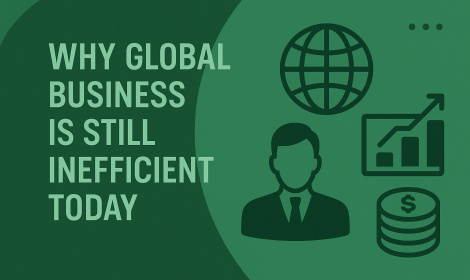Why Global Business Is Still Inefficient Today
Autor: Ondřej, 13.06.2025Major Obstacles for Performance Marketing, Management, and Business Development in Global Trade

One major hurdle for companies attempting to perform efficiently on a global scale involves language barriers. Communication problems can arise not only due to linguistic differences but also due to semantic and cultural distinctions. This frequently results in misunderstood messages, flawed negotiations, and disrupted operations. Solutions include employing proficient multilingual teams, utilizing translation services, and adopting clear and simplified communication strategies.
Access to reliable information stands as another significant barrier. Market data can be incomplete, outdated, or unreliable due to disparate data sources and poor data management practices. This dampens companies’ ability to make well-informed decisions. Implementing robust data validation routines, employing big data technologies, and developing strong data governance practices can aid in navigating these informational bottlenecks.
Lastly, entrenched business stereotypes pose additional obstacles to smooth international operations. Preconceptions about certain markets or business practices can undermine collaboration and create resistance to innovative approaches. Combatting these biases involves education, training, and fostering an organizational culture that values adaptability and an understanding of diverse business environments. Providing incentives for cross-cultural exchanges and collaborative initiatives can aid in dismantling these barriers.
In today's interconnected world, the flow of goods, services, and information crosses borders at an unprecedented rate. This growing connectivity promises greater opportunity, collaboration, and innovation. However, many businesses are still wrestling with inefficiencies stemming from structural weaknesses, policy obstacles, and operational bottlenecks. So why, in spite of these promises, is global business still inefficient today?
One major factor contributing to inefficiency is the persistence of regulatory complexities. Each country maintains its own set of regulations, taxes, labor laws, and intellectual property regimes. This patchwork landscape makes compliance a significant hurdle and a major cost driver for companies trying to operate across borders. The lack of harmonization adds administrative overhead and introduces a degree of uncertainty that dampens investment and growth.
Additionally, logistical bottlenecks and weak digital infrastructures further undermine the smooth flow of international business. Large volumes of documents, from bills of lading to customs forms, still move at a frustratingly slow pace. Paper-based processes, redundancy, and poor interoperability between different digital platforms result in delays and a higher likelihood of error. This not only increases delivery times and operational costs but also erodes customer satisfaction and loyalty.
Cultural differences and communication barriers further contribute to inefficiency. Large, culturally diverse firms often struggle to align goals, collaborate effectively, and make decisions in a coherent and timely manner. This can manifest in redundancy, missed opportunities, and internal conflict — all of which undermine overall competitiveness in a fast-changing market.
Lastly, policy uncertainty stemming from geopolitical tensions and growing protectionism further clouds the outlook for many companies. Tariffs, export controls, and growing policy intervention create an unpredictable landscape that firms must constantly navigate, adding additional complexity and cost to their operations.
Overall, while the potential for a truly connected and efficient global business ecosystem certainly exists, a range of structural, policy, operational, and interpersonal barriers remain in place. Removing these bottlenecks will require policy coordination, technology standardization, greater interpersonal understanding, and a sustained collective effort by stakeholders across borders.